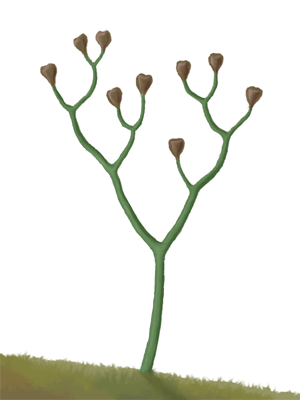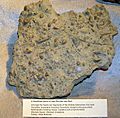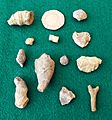Silurian facts for kids
| Silurian Period 443.8–419.2 million years ago |
|
| Mean atmospheric O2 content over period duration | c. 14 vol % (70 % of modern level) |
| Mean atmospheric CO2 content over period duration | c. 4500 ppm (16 times pre-industrial level) |
| Mean surface temperature over period duration | c. 17 °C (3 °C above modern level) |
| Sea level (above present day) | Around 180m, with short-term negative excursions |
|
Epochs in the Silurian
-444 —
–
-442 —
–
-440 —
–
-438 —
–
-436 —
–
-434 —
–
-432 —
–
-430 —
–
-428 —
–
-426 —
–
-424 —
–
-422 —
–
-420 —
–
-418 —
Epochs of the Silurian Period.
Axis scale: millions of years ago. |
|
The Silurian was a time in Earth's history that lasted from about 443.4 million years ago to 419 million years ago. It came right after the Ordovician period and before the Devonian period. Scientists know when this period started and ended because of specific rock layers. However, the exact dates can be off by a few million years. The Silurian period began after a huge event where 60% of all ocean creatures disappeared. This event is called the Ordovician-Silurian extinction.
Contents
Life on Land: First Plants and Animals
The Silurian period was special because it was the first time we find clear signs of life on land. These signs are called fossils. We see fossils of early moss forests growing near lakes and streams. Later in the period, creatures like millipedes and scorpions also started living on land.
Sea Scorpions: Giants of the Ocean
Sea scorpions were very common during the middle of the Silurian period, around 430 million years ago. Their fossils show they were at their peak during this time. These creatures were large and lived in the water.
Early Land Plants: Vascular Plants
The first vascular plants appeared in the second half of the Silurian period. Vascular plants are special because they have tissues that carry water and food throughout the plant. This is like our veins and arteries.
The earliest known vascular plants were Cooksonia and Baragwanathia. Cooksonia fossils are mostly found in the northern part of the world. Baragwanathia fossils are found in Australia.
A simple Silurian land plant was Psilophyton. It had xylem and phloem, which are the tissues that carry water and food. But it didn't have true roots, stems, or leaves like modern plants. Psilophyton was very branched and reproduced using spores. It breathed through tiny holes called stomata on all its surfaces. It probably made its own food through photosynthesis in all parts exposed to light.
Early Land Animals: Predators Emerge
Some evidence suggests that early arachnids (like spiders) and myriapods (like centipedes) lived in the late Silurian. These were predatory invertebrates. Finding predators means that simple food webs were already forming on land. These food webs included animals that were prey for the predators.
Images for kids
-
The line between the Ordovician and Silurian periods on Hovedøya, Norway. It shows brownish late Ordovician mudstone and darker Silurian shale. The layers were pushed over by the Caledonian orogeny.
-
Eurypterus, a common sea scorpion from the Upper Silurian.
-
Poraspis, a type of armored jawless fish from the Late Silurian. It was found in Canada, Norway, and the U.S.
-
Trilobites were still common in the Silurian. Fossils of Calymene celebra are very easy to find in parts of central USA.
-
Parioscorpio was a mysterious arthropod from the Silurian of Wisconsin.
-
A Dalmanites limulurus specimen (a type of trilobite) from Silurian rocks in New York.
-
A rock with several geodized pentamerid brachiopods from rocks in Indiana.
-
Entelognathus primordialis was a Placoderm fish from the late Silurian.
-
Pterygotus was a giant sea scorpion found almost everywhere in the world.
-
Sphooceras was a Nautiloid cephalopod found in Silurian rocks of the Czech Republic.
See also
 In Spanish: Silúrico para niños
In Spanish: Silúrico para niños















